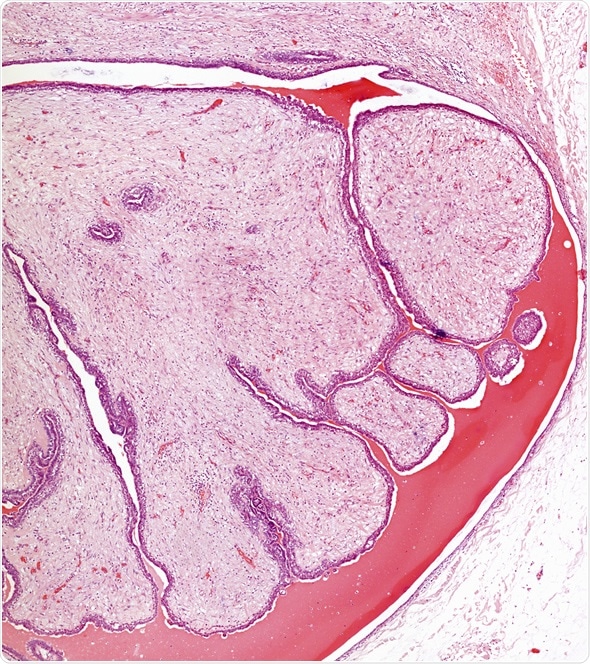Fibroadenomas are considered a common cause of discrete breast masses in young women. The diagnosis of these breast changes is based on the clinically relevant trinity of manual examination, imaging methods, and non-surgical biopsy (which is sometimes also known as the triple test).
Total diagnostic efficacy of the aforementioned three modalities is between 70% and 80%, although they can distinguish between benign and malignant lesions with 95% accuracy rate. Generally, there is an agreement that fibroadenomas can be successfully diagnosed before an operation with a high degree of certainty.

Microscope picture of fibroadenoma of the breast - Image Copyright: Convit / Shutterstock
Medical History and Manual Palpation
Women who present with breast lumps should undergo a thorough medical evaluation, which consists of detailed medical and family history (noting in the process the occurrence of possible breast-related issues in the past), history of radiation or any malignancy, as well as any constitutional symptoms.
Medical providers should start with gathering information about the location of the mass, duration, any change in size (and whether it is dependent on menses), and associated discharge or pain. Even though fibroadenomas can be found practically anywhere in the breast tissue, most of them are located in the upper outer quadrant.
On manual palpation, the examiner should record consistency, delineation, presence or absence of tenderness on palpation, as well as mobility. In cases when the epithelial proliferation is the main component of a fibroadenoma, the surface of the tumor is smooth; conversely, when the epithelial component is compressed within prevailing connective tissue, the surface becomes lobulated.
In either case, the fibroadenoma is ovoid or spherical in shape, mobile and non-tender to palpation. They are well delineated with a “rubbery” consistency (akin to the consistency of a rubber ball). Mobility can be elicited by pressing on one side of the tumor with one finger, with a “bounce back” motion once the finger is released.
Imaging Methods
As mammography has a poor diagnostic yield in the age group when fibroadenomas are most commonly observed, breast sonography is the method of choice for the diagnosis of these lesions. On ultrasound, a fibroadenoma is sharply circumscribed with a round shape, an internal echo pattern, and posterior acoustic shadowing.
Nevertheless, mammography can also be employed in the diagnostic procedure, showing images of a well-circumscribed and homogenous tumor with sharp margins. In some instances, the mammogram may also show a thin and lucent line called a “halo” that surrounds the tumor; this finding represents the connective tissue that delineates the observed fibroadenoma from the surrounding breast tissue.
Aspiration Cytology
Fine needle aspiration is quite a popular technique in the diagnostic evaluation of various breast masses. Aspirates from fibroadenomas are usually cellular with staghorn-shaped clusters of epithelial cells, set within a clean background that contains a plethora of naked bipolar nuclei (giving an appearance of sesame seeds scattered among epithelial fragments).
A presence of customary ductal hyperplasia within the fibroadenoma can result in the presence of larger branched proliferative epithelial clusters in the aspirates. Corresponding histology shows intra-canalicular and peri-canalicular growth pattern.
In conjunction with the clinical diagnosis, fine needle aspiration can enhance the sensitivity of establishing a correct diagnosis to 86% (with a specificity of 76%), but for breast cancer the same technique shows 96% sensitivity and 98% specificity. Therefore, while aspiration cytology can sometimes mix fibroadenomas with some other benign lesions of the breast, incorrectly diagnosing a malignant process seldom happens.
Further Reading